Related Research Articles

Weaving is a method of textile production in which two distinct sets of yarns or threads are interlaced at right angles to form a fabric or cloth. Other methods are knitting, crocheting, felting, and braiding or plaiting. The longitudinal threads are called the warp and the lateral threads are the weft, woof, or filling. The method in which these threads are interwoven affects the characteristics of the cloth. Cloth is usually woven on a loom, a device that holds the warp threads in place while filling threads are woven through them. A fabric band that meets this definition of cloth can also be made using other methods, including tablet weaving, back strap loom, or other techniques that can be done without looms.

The Huguenots were a religious group of French Protestants who held to the Reformed (Calvinist), tradition of Protestantism. The term, which may be derived from the name of a Swiss political leader, the Genevan burgomaster Besançon Hugues (1491–1532), was in common use by the mid-16th century. Huguenot was frequently used in reference to those of the Reformed Church of France from the time of the Protestant Reformation. By contrast, the Protestant populations of eastern France, in Alsace, Moselle, and Montbéliard, were mainly Lutherans.

A ribbon or riband is a thin band of material, typically cloth but also plastic or sometimes metal, used primarily as decorative binding and tying. Cloth ribbons are made of natural materials such as silk, cotton, and jute and of synthetic materials, such as polyester, nylon, and polypropylene. Ribbon is used for useful, ornamental, and symbolic purposes. Cultures around the world use ribbon in their hair, around the body, and as ornament on non-human animals, buildings, and packaging. Some popular fabrics used to make ribbons are satin, organza, sheer,silk,velvet, and grosgrain.

Spitalfields is a district in the East End of London and within the London Borough of Tower Hamlets. The area is formed around Commercial Street and includes the locale around Brick Lane, Christ Church, Toynbee Hall and Commercial Tavern. It has several markets, including Spitalfields Market, the historic Old Spitalfields Market, Brick Lane Market and Petticoat Lane Market. It was a Hamlet of the large ancient parish of Stepney in Middlesex, and became an independent parish in 1729. Just outside the City of London, it formed part of the County of London from 1889 and was part of the Metropolitan Borough of Stepney from 1900. It was abolished as a civil parish in 1921.

Serge is a type of twill fabric that has diagonal lines or ridges on both inner and outer surfaces via a two-up, two-down weave. The worsted variety is used in making military uniforms, suits, greatcoats, and trench coats. Its counterpart, silk serge, is used for linings. French serge is a softer, finer variety. The word is also used for a high-quality woven woolen fabric.
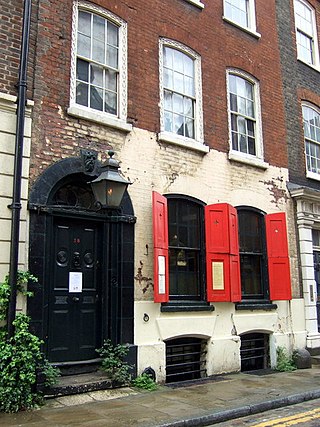
Dennis Severs' House in Folgate Street, London, is a "still-life drama" created by Dennis Severs, who owned and lived in it until his death, as a "historical imagination" of what life would have been like inside for a family of Huguenot silk weavers. It is a Grade II listed Georgian terraced house in Spitalfields in the East End, Central London, England. From 1979 to 1999 it was lived in by Dennis Severs, who gradually recreated the rooms as a time capsule in the style of former centuries. Severs' friend Dan Cruickshank said: "It was never meant to be an accurate historical creation of a specific moment – it was an evocation of a world. It was essentially a theatre set."
A tenterground, tenter ground or teneter-field was an area used for drying newly manufactured cloth after fulling. The wet cloth was hooked onto frames called "tenters" and stretched taut using "tenter hooks", so that the cloth would dry flat and square.
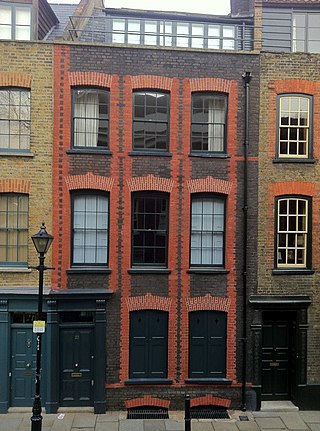
Fournier Street, formerly Church Street, is a street of 18th-century houses in Spitalfields in the East End of London. It is in the London Borough of Tower Hamlets and runs between Commercial Street and Brick Lane. The street is named after a man of Huguenot extraction, George Fournier.
Major John Sewell Courtauld, was an English Conservative Party politician.
The historical immigration to Great Britain concerns the movement of people, cultural and ethnic groups to the British Isles before Irish independence in 1922. Immigration after Irish independence is dealt with by the article Immigration to the United Kingdom since Irish independence.
The Spitalfield riots occurred between 1765 and 1769, during a downturn in the silk weaving industry, centred on Spitalfields in the East End of London. The weavers organised to attempt to ensure that the rates of pay paid for their piece work was not cut beneath the level at which they could feed themselves, and their families.
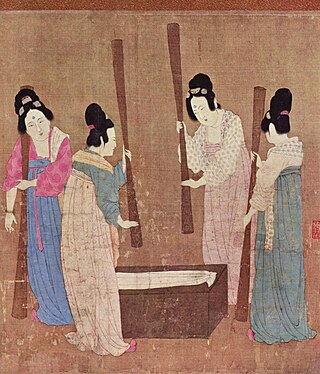
The production of silk originated in Neolithic China within the Yangshao culture. Though it would later reach other places in the world, the art of silk production remained confined to China until the Silk Road opened at 114 BC, though China maintained its virtual monopoly over silk production for another thousand years. The use of silk within China was not confined to clothing alone, and silk was used for a number of applications, such as writing. Within clothing, the color of silk worn also held social importance, and formed an important guide of social class during the Tang dynasty.
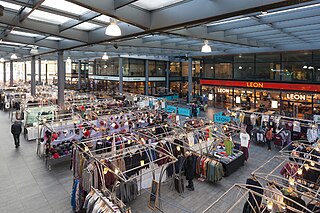
Spitalfields Market is a traders' market as well as a food and art market located in Spitalfields, Central London. Traders began operating around 1666, after the Great Fire of London, where the market stands today. The Spitalfields regeneration programme that ended in 2005, resulted in two new public spaces – Bishops Square and Crispin Place, which restored several historic streets and resulted in more independent retailers and restaurants. Spitalfields Market is situated in the London Borough of Tower Hamlets. It is surrounded by Lamb Street, Old Spitalfields market, Brushfield Street and Bishops Square.

Anna Maria Garthwaite was an English textile designer known for creating vivid floral designs for silk fabrics hand-woven in Spitalfields, London, in the mid-18th century. Garthwaite was acknowledged as one of the premiere English designers of her day. Many of her original designs in watercolours have survived, and silks based on these designs have been identified in portraiture and in costume collections in England and abroad.

French Australians, some of whom refer to themselves as Huguenots, are Australian citizens or residents of French ancestry, or French-born people who reside in Australia. According to the 2011 Census, there were 110,399 people of French descent in Australia and 24,675 French-born people residing in the country at the time of the census, representing an increase of 28.6 percent compared to the 2006 Census. The largest French Australian community is in the state of New South Wales, where they number 8,936 people, many of whom reside in Sydney.

Brick Lane Mosque or Brick Lane Jamme Masjid, formerly known as the London Jamme Masjid, is a Muslim place of worship in Central London and is in the East End of London.

The Coombe is a historic street in the south inner city of Dublin, Ireland. It was originally a hollow or valley where a tributary of the River Poddle, the Coombe Stream or Commons Water, ran. The name is sometimes used for the broader area around, in which the Poddle and its related watercourses featured strongly.

Congleton, Macclesfield, Bollington and Stockport, England, were traditionally silk-weaving towns. Silk was woven in Cheshire from the late 1600s. The handloom weavers worked in the attic workshops in their own homes. Macclesfield was famous for silk buttons manufacture. The supply of silk from Italy was precarious and some hand throwing was done, giving way after 1732 to water-driven mills, which were established in Stockport and Macclesfield.
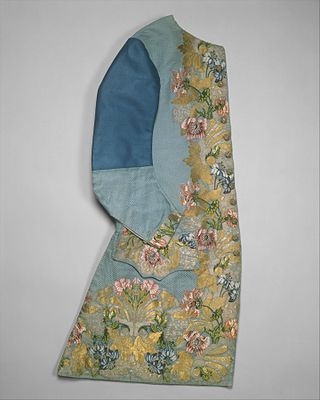
A man's waistcoat with sleeves of 1747 is a rare example of eighteenth century clothing for which the garment itself, the original textile design, and a dated record of both the designer and the master weaver who made the fabric have also survived. The waistcoat is part of the collection of the Costume Institute at the Metropolitan Museum of Art in New York, number C.I.66.14.2.

The Bethnal Green mulberry tree is an ancient black mulberry tree, in the grounds of the former London Chest Hospital, at Bethnal Green in the London Borough of Tower Hamlets.
References
- Footnotes
- ↑ In both Spitalfields and Canterbury, French communities were formed. In Spitalfields there was a cluster of 11 Huguenot churches. Their importance lay not in numbers but the important silk weaving skills that they introduced. They were disciplined and skillful workers.
- Notes
- ↑ Interpretation panel at Rochester's Huguenots' Museum.
- ↑ "Immigration and Emigration: The World in a City". BBC.
- ↑ William Page, ed. (1911). "Industries: Silk-weaving". A History of the County of Middlesex: Volume 2: General; Ashford, East Bedfont with Hatton, Feltham, Hampton with Hampton Wick, Hanworth, Laleham, Littleton. Institute of Historical Research. Retrieved 18 November 2011.
- ↑ Baird, Alison. "Silk in England". Smith University Northampton Silk Project.
- Bibliography